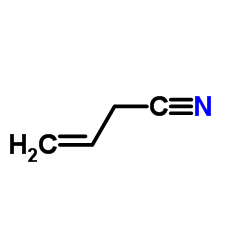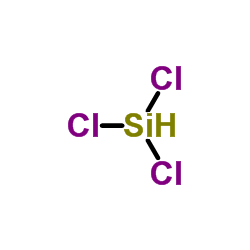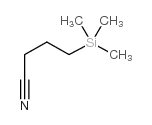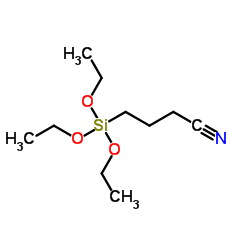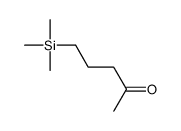1071-27-8
| 中文名 | (3-氰丙基)三氯硅烷 |
|---|---|
| 英文名 | 3-Cyanopropyltrichlorosilane |
| 中文别名 | 3-氰丙基三氯硅烷 |
| 英文别名 |
3-CYANOPROPYLTRICHLOROSILANE
4-(Trichlorosilyl)butanenitrile Butanenitrile, 4-(trichlorosilyl)- 3-cyanopropyltriclorosilane MFCD00013832 γ-cyanopropyltrichlorosilane 4-trichlorosilylbutanenitrile EINECS 213-990-6 |
| 密度 | 1.3±0.1 g/cm3 |
|---|---|
| 沸点 | 237.5±0.0 °C at 760 mmHg |
| 分子式 | C4H6Cl3NSi |
| 分子量 | 202.542 |
| 闪点 | 92.1±22.6 °C |
| 精确质量 | 200.933502 |
| PSA | 23.79000 |
| LogP | 4.05 |
| 外观性状 | Liquid,Clear colorless |
| 蒸汽压 | 0.0±0.4 mmHg at 25°C |
| 折射率 | 1.467 |
| 储存条件 | 储存在干爽的惰性气体下,保持容器密封,储存在阴凉,干燥的地方 |
| 稳定性 | 常温常压下稳定,避免氧化物 碱 胺 酒精 活性金属 水分接触 |
| 分子结构 | 1、 摩尔折射率:43.75 2、 摩尔体积(m3/mol):157.8 3、 等张比容(90.2K):374.0 4、 表面张力(dyne/cm):31.5 5、 介电常数:无可用 6、 偶极距(10 -24cm 3):无可用 7、 极化率:17.34 |
| 计算化学 | 1.疏水参数计算参考值(XlogP):无 2.氢键供体数量:0 3.氢键受体数量:1 4.可旋转化学键数量:2 5.互变异构体数量:无 6.拓扑分子极性表面积23.8 7.重原子数量:9 8.表面电荷:0 9.复杂度:122 10.同位素原子数量:0 11.确定原子立构中心数量:0 12.不确定原子立构中心数量:0 13.确定化学键立构中心数量:0 14.不确定化学键立构中心数量:0 15.共价键单元数量:1 |
| 更多 | 1. 性状:未确定。 2. 密度(g/mL,25℃):1.302 3. 相对蒸汽密度(g/mL,空气=1):未确定 4. 熔点(ºC):未确定 5. 沸点(ºC,常压):237-238 6. 沸点(ºC,30mm):未确定 7. 折射率(n 20/D ):1.464 8. 闪点(ºF):198 9. 比旋光度(º):未确定 10. 自燃点或引燃温度(ºC):未确定 11. 蒸气压(kPa,25ºC):未确定 12. 饱和蒸气压(kPa,60ºC):未确定 13. 燃烧热(KJ/mol):未确定 14. 临界温度(ºC):未确定 15. 临界压力(KPa):未确定 16. 油水(辛醇/水)分配系数的对数值:未确定 17. 爆炸上限(%,V/V):未确定 18. 爆炸下限(%,V/V):未确定 19. 溶解性:未确定 |
Synonym:Butanenitrile, 4-(Trichlorosilyl)-; Silane, Trichloro(3-Cyanopropyl)- Section 2 - COMPOSITION, INFORMATION ON INGREDIENTS
Risk Phrases: 34 Section 3 - HAZARDS IDENTIFICATION EMERGENCY OVERVIEW
Causes burns.Moisture sensitive.Corrosive. Potential Health Effects Eye: Causes eye burns. May cause chemical conjunctivitis and corneal damage. Skin: Causes skin burns. May cause skin rash (in milder cases), and cold and clammy skin with cyanosis or pale color. Ingestion: May cause severe and permanent damage to the digestive tract. Causes gastrointestinal tract burns. May cause perforation of the digestive tract. May cause systemic effects. Inhalation: May cause severe irritation of the respiratory tract with sore throat, coughing, shortness of breath and delayed lung edema. Causes chemical burns to the respiratory tract. Aspiration may lead to pulmonary edema. May cause systemic effects. Chronic: Effects may be delayed. Section 4 - FIRST AID MEASURES Eyes: Get medical aid. Do NOT allow victim to rub eyes or keep eyes closed. Extensive irrigation with water is required (at least 30 minutes). Skin: Get medical aid immediately. Immediately flush skin with plenty of water for at least 15 minutes while removing contaminated clothing and shoes. Wash clothing before reuse. Destroy contaminated shoes. Ingestion: Never give anything by mouth to an unconscious person. Get medical aid. Do NOT induce vomiting. If conscious and alert, rinse mouth and drink 2-4 cupfuls of milk or water. Inhalation: Remove from exposure and move to fresh air immediately. If not breathing, give artificial respiration. If breathing is difficult, give oxygen. Get medical aid. Do NOT use mouth-to-mouth resuscitation. If breathing has ceased apply artificial respiration using oxygen and a suitable mechanical device such as a bag and a mask. Notes to Physician: Section 5 - FIRE FIGHTING MEASURES General Information: As in any fire, wear a self-contained breathing apparatus in pressure-demand, MSHA/NIOSH (approved or equivalent), and full protective gear. During a fire, irritating and highly toxic gases may be generated by thermal decomposition or combustion. Use water spray to keep fire-exposed containers cool. Vapors may be heavier than air. They can spread along the ground and collect in low or confined areas. Contact with metals may evolve flammable hydrogen gas. Containers may explode when heated. Extinguishing Media: Use agent most appropriate to extinguish fire. Do NOT get water inside containers. Cool containers with flooding quantities of water until well after fire is out. Use water spray, dry chemical, carbon dioxide, or appropriate foam. Section 6 - ACCIDENTAL RELEASE MEASURES General Information: Use proper personal protective equipment as indicated in Section 8. Spills/Leaks: Avoid runoff into storm sewers and ditches which lead to waterways. Clean up spills immediately, observing precautions in the Protective Equipment section. Absorb spill using an absorbent, non-combustible material such as earth, sand, or vermiculite. Do not use combustible materials such as sawdust. Provide ventilation. Do not get water inside containers. Section 7 - HANDLING and STORAGE Handling: Wash thoroughly after handling. Use with adequate ventilation. Avoid contact with eyes, skin, and clothing. Do not breathe dust, vapor, mist, or gas. Keep container tightly closed. Avoid ingestion and inhalation. Do not allow contact with water. Discard contaminated shoes. Keep from contact with moist air and steam. Storage: Store in a tightly closed container. Store in a cool, dry, well-ventilated area away from incompatible substances. Corrosives area. Store protected from moisture. Section 8 - EXPOSURE CONTROLS, PERSONAL PROTECTION Engineering Controls: Facilities storing or utilizing this material should be equipped with an eyewash facility and a safety shower. Use adequate ventilation to keep airborne concentrations low. Exposure Limits CAS# 1071-27-8: United Kingdom, WEL - TWA: (listed as silica, amorphous): 6 mg/m3 (inhalable dust); 2.4 mg/m3 TWA (respirable dust) United Kingdom, WEL - STEL: (listed as silica, amorphous): 18 mg/ STEL (inhalable dust); 7.2 mg/m3 STEL (respirable dust) Russia: (listed as silica, amorphous): 1 mg/m3 TWA Personal Protective Equipment Eyes: Wear appropriate protective eyeglasses or chemical safety goggles as described by OSHA's eye and face protection regulations in 29 CFR 1910.133 or European Standard EN166. Skin: Wear appropriate protective gloves to prevent skin exposure. Clothing: Wear appropriate protective clothing to prevent skin exposure. Respirators: A respiratory protection program that meets OSHA's 29 CFR 1910.134 and ANSI Z88.2 requirements or European Standard EN 149 must be followed whenever workplace conditions warrant respirator use. Section 9 - PHYSICAL AND CHEMICAL PROPERTIES Physical State: Liquid Color: clear, colorless Odor: chlorine-like pH: Not available. Vapor Pressure: Not available. Viscosity: Not available. Boiling Point: 94 deg C @ 8.00mm Hg Freezing/Melting Point: Not available. Autoignition Temperature: Not available. Flash Point: 198 deg F ( 92.22 deg C) Explosion Limits, lower: Not available. Explosion Limits, upper: Not available. Decomposition Temperature: Solubility in water: Specific Gravity/Density: 1.2800g/cm3 Molecular Formula: C4H6Cl3NSi Molecular Weight: 202.54 Section 10 - STABILITY AND REACTIVITY Chemical Stability: Stable at room temperature in closed containers under normal storage and handling conditions. Conditions to Avoid: Incompatible materials, moisture, excess heat. Incompatibilities with Other Materials: Moisture, strong acids, strong bases, strong oxidizing agents, strong reducing agents. Hazardous Decomposition Products: Hydrogen chloride, carbon monoxide, oxides of nitrogen, irritating and toxic fumes and gases, carbon dioxide, oxides of silicon. Hazardous Polymerization: Has not been reported Section 11 - TOXICOLOGICAL INFORMATION RTECS#: CAS# 1071-27-8: VV2775000 LD50/LC50: CAS# 1071-27-8: Oral, rat: LD50 = 2830 mg/kg. Carcinogenicity: Butanenitrile, 4-(Trichlorosilyl)- - Not listed by ACGIH, IARC, or NTP. Other: See actual entry in RTECS for complete information. Section 12 - ECOLOGICAL INFORMATION Section 13 - DISPOSAL CONSIDERATIONS Dispose of in a manner consistent with federal, state, and local regulations. Section 14 - TRANSPORT INFORMATION IATA Shipping Name: CHLOROSILANES, CORROSIVE, N.O.S. Hazard Class: 8 UN Number: 2987 Packing Group: II IMO Shipping Name: CHLOROSILANES, CORROSIVE, N.O.S. Hazard Class: 8 UN Number: 2987 Packing Group: II RID/ADR Shipping Name: CHLOROSILANES, CORROSIVE, N.O.S. Hazard Class: 8 UN Number: 2987 Packing group: II Section 15 - REGULATORY INFORMATION European/International Regulations European Labeling in Accordance with EC Directives Hazard Symbols: C Risk Phrases: R 34 Causes burns. Safety Phrases: S 24/25 Avoid contact with skin and eyes. S 28A After contact with skin, wash immediately with plenty of water. S 37 Wear suitable gloves. S 45 In case of accident or if you feel unwell, seek medical advice immediately (show the label where possible). WGK (Water Danger/Protection) CAS# 1071-27-8: No information available. Canada CAS# 1071-27-8 is listed on Canada's NDSL List. CAS# 1071-27-8 is not listed on Canada's Ingredient Disclosure List. US FEDERAL TSCA CAS# 1071-27-8 is listed on the TSCA inventory. SECTION 16 - ADDITIONAL INFORMATION N/A |
|
毒理学数据: 1、急性毒性: 大鼠口经LD50:2830mg/kg 生态学数据: 对水是稍微有害的,不要让未稀释或大量的产品接触地下水,水道或者污水系统,若无政府许可,勿将材料排入周围环境 CHEMICAL IDENTIFICATION
HEALTH HAZARD DATAACUTE TOXICITY DATA
|
| 符号 |


GHS05, GHS07 |
|---|---|
| 信号词 | Danger |
| 危害声明 | H314-H335 |
| 补充危害声明 | Reacts violently with water. |
| 警示性声明 | P261-P280-P305 + P351 + P338-P310 |
| 个人防护装备 | Faceshields;full-face respirator (US);Gloves;Goggles;multi-purpose combination respirator cartridge (US);type ABEK (EN14387) respirator filter |
| 危害码 (欧洲) | C: Corrosive; |
| 风险声明 (欧洲) | R14 |
| 安全声明 (欧洲) | S26-S36/37/39-S45 |
| 危险品运输编码 | UN 2987 8/PG 2 |
| WGK德国 | 2 |
| RTECS号 | VV2775000 |
| 包装等级 | II |
| 危险类别 | 8 |
| 海关编码 | 2931900090 |
|
~% 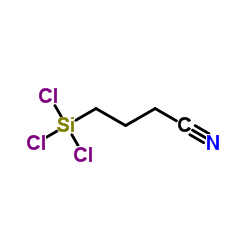
1071-27-8 |
| 文献:Journal of the American Chemical Society, , vol. 80, p. 1737 |
|
~% 
1071-27-8 |
| 文献:Bulletin of the Chemical Society of Japan, , vol. 29, p. 784,785, 787 |
| 上游产品 2 | |
|---|---|
| 下游产品 4 | |
| 海关编码 | 2931900090 |
|---|---|
| 中文概述 | 2931900090. 其他有机-无机化合物. 增值税率:17.0%. 退税率:13.0%. 监管条件:AB(入境货物通关单,出境货物通关单). 最惠国关税:6.5%. 普通关税:30.0% |
| Summary | 2931900090. other organo-inorganic compounds. VAT:17.0%. Tax rebate rate:13.0%. Supervision conditions:AB(certificate of inspection for goods inward,certificate of inspection for goods outward). MFN tariff:6.5%. General tariff:30.0% |


